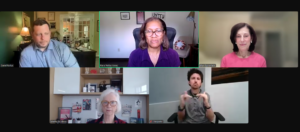“One of the greatest accomplishments of our time is the extension of the human lifespan,” said Martha Boudreau, chief communications and marketing officer for AARP. “Many people are living into their 90s, or even to 100. Take advantage of the extra years we’ve been given.”
Boudreau was a panelist for PRSA’s most recent Diverse Dialogues livestream on May 16 titled, “Shifting Perspectives: Debunking ‘Age Is Just a Number.’”
For many people, living longer means working longer — or at least having the desire to continue their careers, despite the barriers they face. But while discussions of workplace discrimination emphasize race, gender and sexual orientation, bias against older workers is often overlooked.
Age discrimination “will impact you in some way, shape or form,” because of people’s uninformed assumptions, said panelist Daniel Farkas, who lectures on strategic communications at the Ohio State University in Columbus.
Rene Petties-Jones, president of the National Federation for Just Communities of Western New York, a nonprofit advocacy group in Buffalo, moderated the event. Petties-Jones, who is also the co-chair of PRSA’s DEI Committee, asked the panelists how they define ageism.
Panelist Ellen Oppenheim, a marketing consultant, said the word means “a predisposition, a judgment, a cultural prejudice…that affects everybody.”
Companies often phase out older workers who earn higher salaries, but those organizations lose valuable experience and institutional knowledge in the process, Oppenheim said. Some companies are pairing younger workers with older workers, who can mentor one another on their respective areas of knowledge.

More experienced workers can show those just starting their careers how to finesse a tricky situation with a client, for example, those “delicate issues that you’re not necessarily taught in school, but you’re expected to handle in business,” Oppenheim said. However, many organizations “fail to recognize the benefits of a multigenerational workforce.”
Rather than see the generation gap between older and younger workers, “it’s important to focus on what they have in common,” Oppenheim said.
Stay current, chart your path.
For workers who earned college degrees long ago, “micro-credentialing is absolutely essential” to keep their skills up-to-date, Boudreau said. Workers whose salaries have increased over the years might cost more for companies to employ, but clients — including those of communications firms — should demand experience, she said.
Farkas, who works with college students who are preparing to enter the workforce, said that younger workers might be less expensive for companies to employ, but they also tend to have poor grammar and writing skills — distinct liabilities in the communications field.
“You must know how to write if you’re going to be successful in this business,” said Boudreau, who worked for years to develop her writing and editing skills. Even in the age of artificial intelligence technology that offers to do your writing for you, “Intellectual curiosity and strong writing are the foundations of success in the communications business.”
When overcoming ageism and its stereotypes, “We need to celebrate the activity level of people in the second half of their lives,” Oppenheim said. And with many living for nearly a century, that second act begins at 50.
Countering discrimination against older, more experienced workers is an uphill climb. But individuals shouldn’t allow themselves to be pigeonholed by age. As Oppenheim said, “Make sure you’re keeping up with your skill set. Keep your professional network alive.” Perhaps most important: “Bust out of what the perceptions are and chart your own path.”
You can watch the Diverse Dialogues session via this link.
[Photo credit: epiximages]







